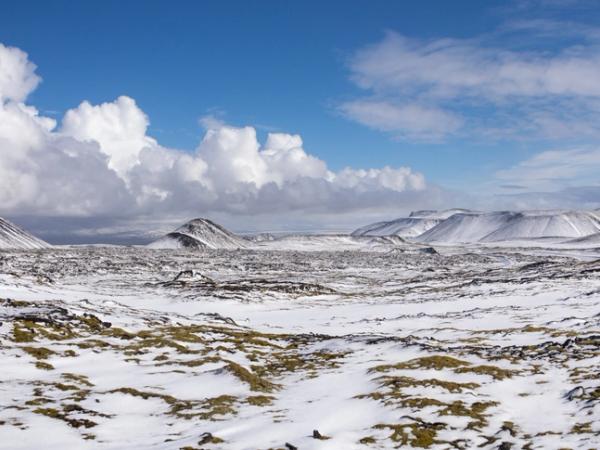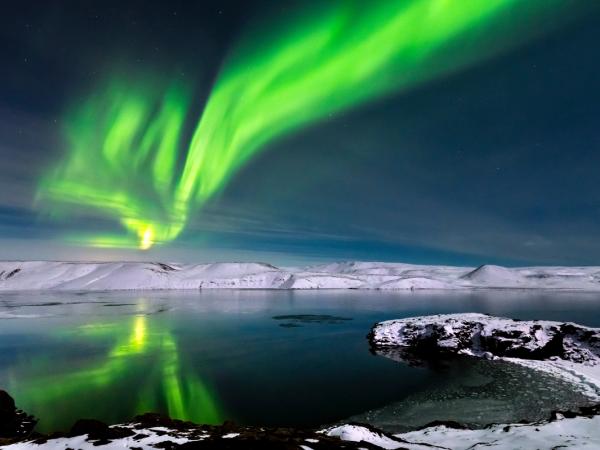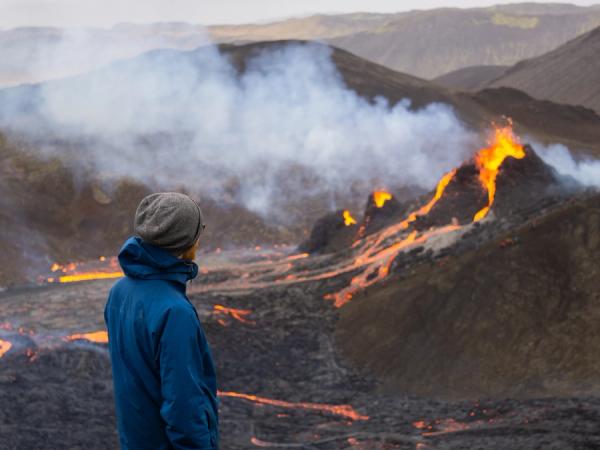
The Reykjanes Peninsula: Iceland's Volcanic Wonderland
Iceland's Reykjanes Peninsula is a place where two worlds collide - literally. Here, fiery volcanoes emerge from icy landscapes, creating a playground for geology lovers and adventure seekers alike. Most travelers zoom past this region on their way from the airport, missing out on some of Iceland's most exciting natural wonders hiding in plain sight.
Key Takeaways
- Reykjanes Peninsula offers amazing geology with active volcanoes and hot springs just 20 minutes from Keflavík Airport.
- Recent eruptions at Fagradalsfjall (2021, 2022, 2023, and 2025) have created new landscapes to explore.
- The Blue Lagoon is the big draw, but you'll also find great hiking trails, geothermal areas, and cultural sites.
- Visit between May and September for better weather and open hiking trails, or winter for a chance to see the Northern Lights.
- Stay anywhere from budget Airport Hotel Aurora Star to the fancy Retreat at the Blue Lagoon.
What's the Reykjanes Peninsula?
The Reykjanes Peninsula sits in southwest Iceland, where two tectonic plates meet. This UNESCO Global Geopark is a place where North America and Europe pull apart right before your eyes. With lava fields, bubbling mud pools, steaming hot springs, and active volcanoes, it feels like you're walking on another planet.
Most people who visit Iceland pass through Reykjanes first since it's home to Keflavík Airport, but many rush off to Reykjavík or the Golden Circle. That's a mistake. This often-skipped region has some of Iceland's best natural wonders without the big crowds.
The name Reykjanes means "smoky peninsula," which fits perfectly for a place where steam rises from the ground and lava sometimes breaks through the surface. It's a place of stark contrasts – black lava fields next to the blue Atlantic Ocean, shaped by millions of years of earth-moving activity.
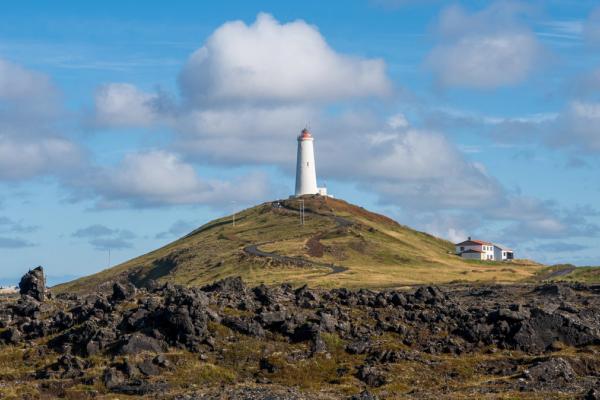
Formation & Geology
The Reykjanes Peninsula is young in geological terms, forming about 6-7 million years ago through a process that's still shaping it today. It formed when tectonic activity shifted eastward toward Iceland's current hotspot under Vatnajökull glacier.
The peninsula sits right on the Mid-Atlantic Ridge, where the Eurasian and North American plates pull apart at about 1.8 centimeters each year. This slow pulling creates a tension zone that releases pressure through earthquakes and volcanic eruptions roughly every 800-1,000 years.
What makes the geology here so cool is how much variety you'll find:
- Lava fields that cover most of the peninsula
- Cone-shaped mountains called tuyas (like Keilir) that formed under ice sheets
- Ridges that were created when lava erupted beneath glaciers
- Shield volcanoes formed after the last ice age ended 12,000-15,000 years ago
All this tectonic activity has given the region lots of geothermal energy. Rainwater seeps into the ground, gets heated by magma below, and creates hot springs, steam vents, and mud pots across the landscape. This same energy powers plants like Svartsengi, which makes electricity and hot water for nearby towns.
Walking across the peninsula is like seeing a geology textbook come to life. The ground beneath your feet tells a story of ice ages, volcanic eruptions, and constant change—a story that's still being written today.
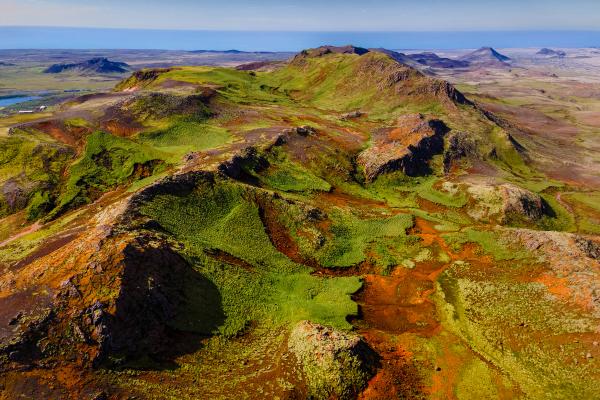
Volcanoes & Volcanic Activity
The Reykjanes Peninsula has several volcanic systems that have shaped its wild landscape. Recent eruptions have put this area back on the map, especially at Fagradalsfjall.
The peninsula has six main volcanic systems lined up from northeast to southwest:
- Fagradalsfjall: This system grabbed worldwide attention with eruptions in 2021, 2022, 2023, and again in 2025. Unlike the explosive eruptions you might see elsewhere, Fagradalsfjall produced gentle lava flows that created new hills and valleys. Visitors get the rare chance to see new earth being formed right before their eyes. The hiking trails to viewpoints offer some of Iceland's most amazing volcanic views. Nearby, Litli-Hrútur, part of the same volcanic system, erupted in 2023, adding to the area's dynamic landscape with fresh lava fields.
- Reykjanes-Svartsengi: These two systems are often grouped together because they're so similar. They cover the southwestern tip of the peninsula. The last major eruption ended in 1240 CE, but recent earthquake swarms suggest things might be waking up again. This system powers the famous Blue Lagoon through its geothermal energy.
- Krýsuvík: Known for its colorful geothermal areas with mud pots and steam vents, Krýsuvík shows off the peninsula's ongoing heat activity. It hasn't erupted recently, but the bubbling earth and steam remind visitors of the heat below the surface.
- Brennisteinsfjöll: This system features geothermal activity and sulfur deposits, with steam vents and hot springs throughout the area.
- Hengill: At the eastern edge of the peninsula, Hengill has a central volcano with different rock types than the rest of the peninsula.
- Eldey: Mostly underwater, this system extends from the Reykjanes Ridge beneath the ocean.
Scientists keep close tabs on the peninsula with seismic stations, GPS receivers, gas monitors, and webcams. Before the 2021 Fagradalsfjall eruption, over 50,000 earthquakes shook the area, showing just how active this landscape is.
The volcanic systems here don't just create cool landscapes—they help scientists understand how our planet works. For visitors, they offer memories of nature at its most powerful and awe-inspiring.
When visiting active volcanic areas, always check current alerts from the Icelandic Met Office and follow safety guidelines. Local officials set up viewing areas during eruptions to keep people safe while letting them see nature at work.
Location & How to Get There
The Reykjanes Peninsula sits in southwest Iceland, stretching into the Atlantic Ocean. It's where Europe and North America meet, both in terms of geology and location. The region runs from near Reykjavík to Iceland's southwestern tip, including towns like Keflavík, Grindavík, and Hafnarfjörður.
Getting to Reykjanes is super easy because it's home to Keflavík International Airport (KEF), Iceland's main gateway. This makes the peninsula perfect for your first or last stop in Iceland—or even for a quick visit during a layover.
From Keflavík Airport:
- By campervan: Renting a campervan (or car) gives you the most freedom to explore. Main roads are good for standard vehicles, and it takes just about 20 minutes to drive to the Blue Lagoon, or 30 minutes to reach Grindavík.
- By bus: Public buses connect the airport to Reykjavík, stopping at key points on the peninsula. Airport Express and Flybus run often and can drop you at major spots like the Blue Lagoon.
- Tours: Many companies offer day tours of the peninsula from both the airport and Reykjavík, from basic sightseeing to special volcano or hot spring trips.
From Reykjavík:
- By campervan: The drive from Reykjavík to the heart of the peninsula takes about 30-45 minutes on Route 41.
- By bus: Regular public buses connect Reykjavík to towns across the peninsula.
If you plan to visit volcanic areas or less-traveled spots, think about getting a 4x4, especially in winter. But main attractions like the Blue Lagoon, Bridge Between Continents, and Gunnuhver Hot Springs are easy to reach in a standard vehicle on paved or good gravel roads.
The peninsula is compact, so you can see many highlights in just one day, though staying 2-3 days lets you explore more deeply. Many visitors stop at the Blue Lagoon for a few hours before their flight home, while others use the peninsula as a base for their whole Iceland trip.
Things to Do in the Reykjanes Peninsula
The Reykjanes Peninsula packs a lot of variety into a small area. Here are some of the best things to see and do:
The Blue Lagoon
Iceland's most famous spot lives up to the hype. This milky-blue geothermal spa near the Svartsengi power plant offers a luxury soak in mineral-rich waters. Basic entry (around $75) includes the main lagoon, one silica mud mask, and one drink, while premium packages (approximately $95) add a bathrobe, two extra mud masks, one extra drink, and restaurant bookings. Book well ahead, especially in summer.
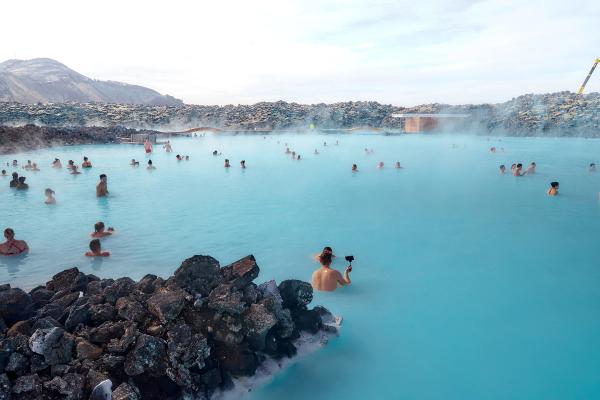
Gunnuhver Hot Springs
Named after a legendary ghost, this area has Iceland's largest mud pool and impressive steam vents. Wooden walkways let you safely watch the boiling, hissing earth. These springs are too hot for bathing, but the alien landscape makes for great photos and shows the power of what's beneath your feet.

Krýsuvík Geothermal Area
Colorful mud pots and steam vents create a Mars-like landscape at this easy-to-reach site. Walkways guide you through fields of bubbling, sulfur-smelling pools surrounded by yellow, red, and green mineral deposits.
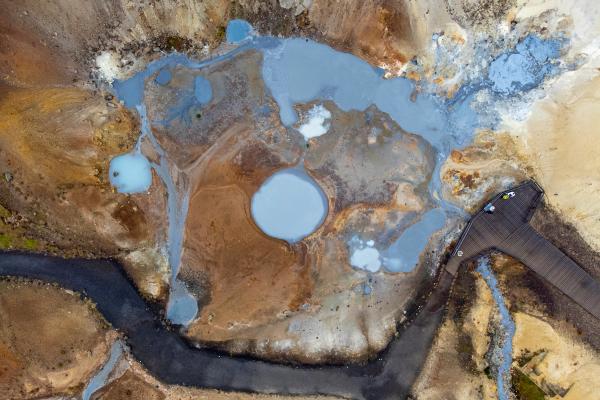
Bridge Between Continents
Stand with one foot in Europe and one in North America at this small footbridge over a rift between tectonic plates. While not the only place to see the Mid-Atlantic Ridge in Iceland, it's the most accessible and clearly marked, making for a fun photo op and a real-world lesson in continental drift.
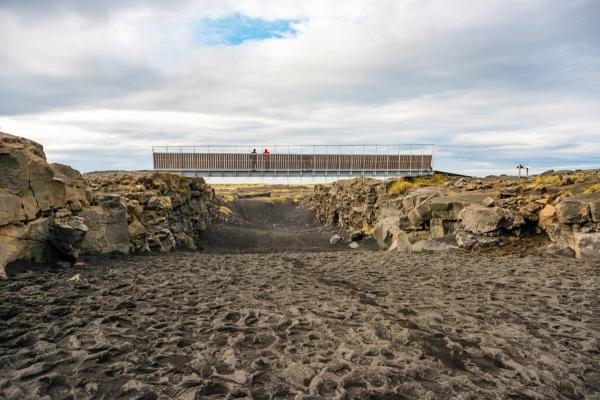
Fagradalsfjall Volcano
The site of recent eruptions offers some of Iceland's most dramatic scenery. Hiking trails of different difficulty levels lead to viewpoints over fresh lava flows and, when active, erupting craters. Even when quiet, the black, twisted lava fields with steam still rising from cooling rocks create an unforgettable landscape.
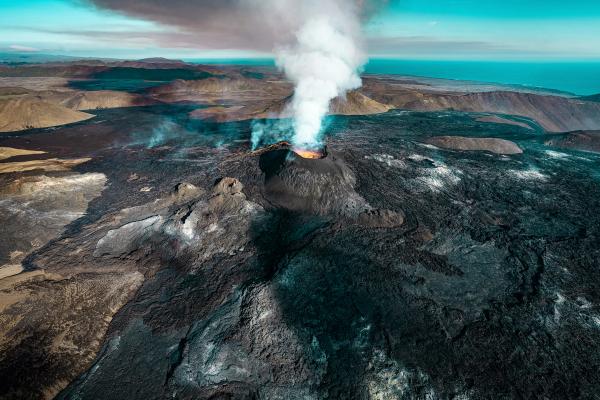
Kleifarvatn Lake
This deep, mysterious lake is surrounded by stark volcanic terrain. Local legends say it holds a monster similar to Scotland's Nessus, but the real draw is the dramatic scenery. The lake sometimes shrinks after earthquakes, showing geothermal activity along its shores.

Selatangar Ruins
These eerie ruins of a 19th-century fishing station sit isolated among lava fields on the southern coast. The hike there is as rewarding as the destination.

Hvalsneskirkja Church
Built in 1887 from black basalt stone, this church near Sandgerði has beautiful wood carvings and stained glass. The cemetery holds the grave of Hallgrímur Pétursson, author of Iceland's most famous religious poems.

Giantess Cave (Gígvatnsvatn)
According to Iceland’s folklore, this lava tube cave was home to a giantess who would steal sheep. Today, it's a fascinating geological formation offering a peek below the surface of the lava fields.
Hiking and Outdoor Activities
Reykjanes is a paradise for hiking lovers, with trails for all levels.
Reykjanes Coastal Path
This 37-kilometer trail winds along dramatic cliffs and beaches, through lava fields, and past lighthouses. You can do sections as day hikes or arrange longer treks.

Keilir Mountain
This cone-shaped mountain offers a moderate hike with panoramic views from the top. The 3-4 hour round trip takes you through moss-covered lava fields before climbing the steep sides of this ancient volcanic formation.
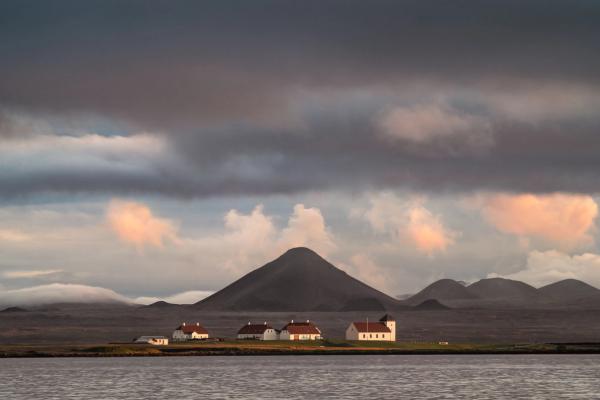
Birdwatching
The coastal cliffs around the peninsula host many seabird species, including puffins (in summer), kittiwakes, and fulmars. The Hafnaberg cliffs and Garðskagi Point are especially good spots.
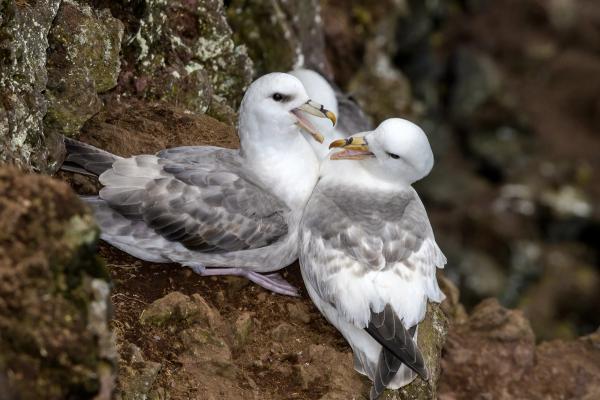
Cultural Attractions
Not everything here is nature. Reykjanes is also home to some pretty cool museums and historical buildings.
Viking World Museum
Located in Njarðvík, this museum houses the Íslendingur, a full-scale replica of a Viking ship that sailed to North America in 2000. Exhibits explain Iceland's settlement and Norse mythology. Tickets for adults cost $27.
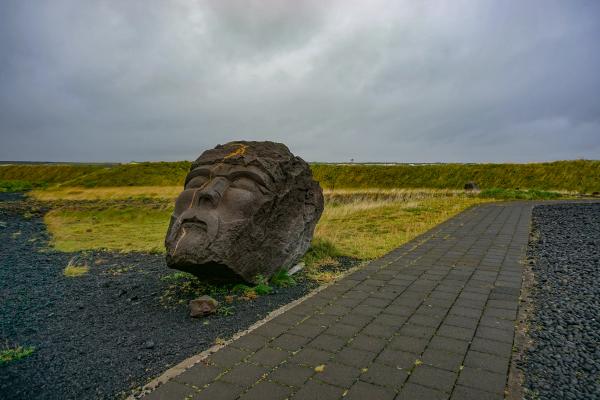
Icelandic Museum of Rock 'n' Roll
Keflavík once had a U.S. military base that brought rock music to Iceland, starting a cultural revolution. This interactive museum celebrates Iceland's surprisingly big music scene, from Björk to Sigur Rós. The museum is currently closed, but it plans to reopen in June 2025, free of charge for all visitors.
Garður Old Church
This pretty stone church in the fishing village of Garður offers a glimpse into traditional Icelandic life, with nearby lighthouses adding to the coastal charm.
Most attractions on the peninsula are open year-round, though some hiking trails may be closed during winter. If you're focusing just on the Reykjanes Peninsula, allow at least two full days to see the main highlights without rushing. Many visitors combine a peninsula tour with time in Reykjavík or as the starting point for a longer Iceland road trip.
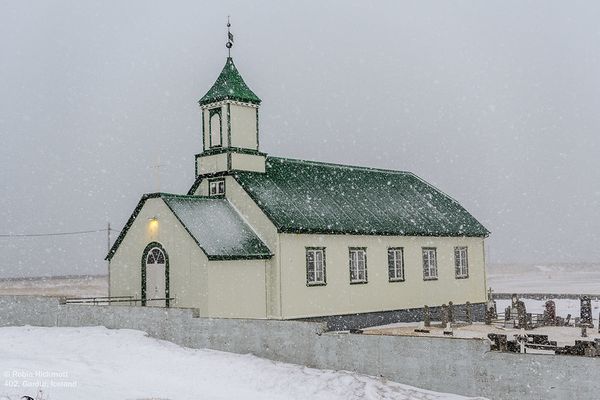
Weather & Best Time to Visit
The Reykjanes Peninsula has a subpolar oceanic climate, with cool summers and fairly mild winters compared to other places at similar latitudes. Its spot on Iceland's southwestern coast puts it in the path of Atlantic weather systems, so conditions can change quickly and sometimes dramatically. Always check the forecast before heading out. The Icelandic Met Office provides good forecasts and weather warnings.
Wind is perhaps the most critical weather factor to consider. Even on otherwise nice days, strong winds can make hiking hard and temperatures feel much colder than what the thermometer shows. Always check wind forecasts and take extra care when visiting coastal cliffs during windy conditions.
Road conditions can be challenging in winter, with ice and occasional snow. While main routes are generally well-maintained, smaller roads may be temporarily closed after storms. If visiting between November and April, check road conditions at road.is before setting out.
Summer (June-August):
- Temperatures usually range from 10-15°C (50-59°F)
- Daylight lasts for nearly 24 hours in June (Midnight Sun)
- Rainfall averages 50-70mm per month
- Wind speeds are generally lower than in winter
Fall (September-October):
- Temperatures cool to 5-10°C (41-50°F)
- Daylight hours drop quickly
- First chances to see Northern Lights
- Weather becomes more changeable with occasional storms
Winter (November-March):
- Temperatures hover around 0°C (32°F), rarely dropping below -10°C (14°F)
- Daylight is limited (4-6 hours in December)
- Snow is common but rarely deep due to coastal location
- Wind can be strong, making it feel much colder
Spring (April-May):
- Temperatures gradually rise to 5-10°C (41-50°F)
- Daylight increases dramatically
- Weather remains unpredictable with rain, snow, and sun possible in a single day
- Migrating birds begin returning
Best Time to Visit
The best time to visit Reykjanes depends on what you want to do:
For hiking and general exploration (May-September): The warmer months offer longer days, more open trails, and milder weather. Late May through early September provides the most reliable conditions for outdoor activities, with June and July experiencing the Midnight Sun, which allows for extended exploration.
For volcano viewing (year-round, when active): When eruptions are happening, they can be seen any time of year. Summer offers better access and warmer conditions, while winter eruptions create dramatic contrasts between snow, darkness, and glowing lava.
For Northern Lights (September-April): The darker months provide chances to see the aurora borealis. September, October, March, and April offer a balance of darkness for aurora viewing and enough daylight for daytime activities.
For fewer crowds and lower prices (October-April, excluding Christmas/New Year): The shoulder and off-seasons bring fewer tourists, especially at popular sites like the Blue Lagoon. Early May and late September can offer a sweet spot of decent weather with fewer crowds.
Regardless of when you visit, be sure to pack layers, waterproof outerwear, and sturdy footwear. The Icelandic saying that "if you don't like the weather, wait five minutes" definitely applies to Reykjanes.
Campsites in the Reykjanes Peninsula
For travelers who want to get closer to nature without breaking the bank, camping offers a great way to experience the raw beauty of the Reykjanes Peninsula. Most campsites are open from May to September, though a few welcome visitors year-round. Here's a rundown of the best spots to pitch your tent or park your campervan:
Garðskagi Campsite
Located at the peninsula's northernmost point, this year-round campsite gives you front-row seats to ocean views and is nestled between two historic lighthouses. It's perfect for bird-watching, spotting whales from the shore, and catching the Northern Lights in winter. The site has toilets, showers, and electricity hookups. After a day of exploring, you can grab a meal at the nearby Restaurant Röstin and watch the sunset over the Atlantic. It’s one of the cheapest in the area (1700 ISK or $13), but also one of the most basic when it comes to facilities.
Grindavík Campsite
Good news! The Grindavik campsite is open again! This family-friendly spot was once named one of Iceland's best campsites. it offers top-notch facilities including hot showers with unlimited hot water, a kitchen area, playgrounds for kids, and BBQ stations. Its location puts you just 20 minutes from both the Blue Lagoon and Keflavík Airport, making it super convenient for exploring the peninsula's highlights.
Hafnarfjörður Camping
Run by Hraunbúar scouts, this campsite sits in a green park surrounded by lava fields about 20 minutes from Reykjavík. It offers a good mix of nature and urban access, with toilets, showers, laundry facilities, a kitchen, and Wi-Fi. The nearby town of Hafnarfjörður has shops, restaurants, and a swimming pool, plus it's known for its Viking heritage and elf folklore. The fare for adults is 1900 ISK ($15).
Vogar Camping
This smaller, quieter option in the town of Vogar provides basic but reliable amenities, including a kitchen, showers, and free Wi-Fi. It's less crowded than larger sites and makes a good base for exploring the peninsula's volcanic attractions. Prices start at 2800 ISK ($22).
Sandgerði Campsite
Just 8 minutes from Keflavík Airport, this campsite in a peaceful coastal village is perfect for your first or last night in Iceland. It offers the standard facilities, including toilets, showers, and electricity hookups, and puts you close to coastal attractions like the Hvalsneskirkja Church. Entry is 2000 ISK ($15.50).

Conclusion
The Reykjanes Peninsula gives you a perfect introduction to Iceland's raw natural beauty and geological wonders. Instead of rushing past on your way to or from the airport, take time to explore this fascinating region where two continents drift apart before your eyes. From relaxing in mineral-rich hot springs to hiking across fresh lava fields, Reykjanes offers experiences that capture the essence of Iceland without the crowds you see at more famous destinations.




